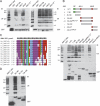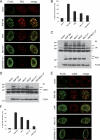UMI, a novel RNF168 ubiquitin binding domain involved in the DNA damage signaling pathway
- PMID: 21041483
- PMCID: PMC3019843
- DOI: 10.1128/MCB.00818-10
UMI, a novel RNF168 ubiquitin binding domain involved in the DNA damage signaling pathway
Abstract
Ubiquitination regulates important cellular processes, including the DNA damage response (DDR) and DNA repair. The complexity of the ubiquitin-mediated signals is decoded by ubiquitin receptors, which contain protein modules named ubiquitin binding domains (UBDs). We previously identified a new ubiquitin ligase, RNF168, involved in DDR and endowed with two UBDs named MIU (motif interacting with ubiquitin). Here we have provided the identification of a novel UBD, the UMI (UIM- and MIU-related UBD), present in RNF168, and characterized the interaction surface with ubiquitin, centered on two Leu residues. We have demonstrated that integrity of the UMI, in addition to the MIUs, is necessary for the proper localization of RNF168 and for ubiquitination of nuclear proteins, including histone H2A. Finally, we have shown that simultaneous inactivation of UMI and MIUs prevents the recruitment to DDR foci of the crucial downstream mediator 53BP1.
Figures





Similar articles
-
RNF168 promotes noncanonical K27 ubiquitination to signal DNA damage.Cell Rep. 2015 Jan 13;10(2):226-38. doi: 10.1016/j.celrep.2014.12.021. Epub 2015 Jan 8. Cell Rep. 2015. PMID: 25578731
-
53BP1 is a reader of the DNA-damage-induced H2A Lys 15 ubiquitin mark.Nature. 2013 Jul 4;499(7456):50-4. doi: 10.1038/nature12318. Epub 2013 Jun 12. Nature. 2013. PMID: 23760478 Free PMC article.
-
A small ubiquitin binding domain inhibits ubiquitin-dependent protein recruitment to DNA repair foci.Cell Cycle. 2013 Dec 15;12(24):3749-58. doi: 10.4161/cc.26640. Epub 2013 Oct 3. Cell Cycle. 2013. PMID: 24107634 Free PMC article.
-
New answers to the old RIDDLE: RNF168 and the DNA damage response pathway.FEBS J. 2022 May;289(9):2467-2480. doi: 10.1111/febs.15857. Epub 2021 Apr 16. FEBS J. 2022. PMID: 33797206 Free PMC article. Review.
-
Crosstalk between histone modifications during the DNA damage response.Trends Cell Biol. 2009 May;19(5):207-17. doi: 10.1016/j.tcb.2009.03.001. Epub 2009 Apr 1. Trends Cell Biol. 2009. PMID: 19342239 Review.
Cited by
-
The nucleosome acidic patch plays a critical role in RNF168-dependent ubiquitination of histone H2A.Nat Commun. 2014;5:3291. doi: 10.1038/ncomms4291. Nat Commun. 2014. PMID: 24518117 Free PMC article.
-
The role of ubiquitin-dependent segregase p97 (VCP or Cdc48) in chromatin dynamics after DNA double strand breaks.Philos Trans R Soc Lond B Biol Sci. 2017 Oct 5;372(1731):20160282. doi: 10.1098/rstb.2016.0282. Philos Trans R Soc Lond B Biol Sci. 2017. PMID: 28847819 Free PMC article. Review.
-
Retroviral insertional mutagenesis implicates E3 ubiquitin ligase RNF168 in the control of cell proliferation and survival.Biosci Rep. 2017 Aug 31;37(4):BSR20170843. doi: 10.1042/BSR20170843. Epub 2017 Jul 27. Biosci Rep. 2017. PMID: 28754805 Free PMC article.
-
A novel ubiquitin mark at the N-terminal tail of histone H2As targeted by RNF168 ubiquitin ligase.Cell Cycle. 2012 Jul 1;11(13):2538-44. doi: 10.4161/cc.20919. Epub 2012 Jul 1. Cell Cycle. 2012. PMID: 22713238 Free PMC article.
-
TRIP12 as a mediator of human papillomavirus/p16-related radiation enhancement effects.Oncogene. 2017 Feb 9;36(6):820-828. doi: 10.1038/onc.2016.250. Epub 2016 Jul 18. Oncogene. 2017. PMID: 27425591 Free PMC article.
References
-
- Acconcia, F., S. Sigismund, and S. Polo. 2009. Ubiquitin in trafficking: the network at work. Exp. Cell Res. 315:1610-1618. - PubMed
-
- Bergink, S., and S. Jentsch. 2009. Principles of ubiquitin and SUMO modifications in DNA repair. Nature 458:461-467. - PubMed
-
- Bhoj, V. G., and Z. J. Chen. 2009. Ubiquitylation in innate and adaptive immunity. Nature 458:430-437. - PubMed
-
- Chen, Z. J., and L. J. Sun. 2009. Nonproteolytic functions of ubiquitin in cell signaling. Mol. Cell 33:275-286. - PubMed
Publication types
MeSH terms
Substances
LinkOut - more resources
Full Text Sources
Other Literature Sources
Molecular Biology Databases
Research Materials
Miscellaneous
